State of CDC Archive
Improve Global Health
CDC pursues its public health mission globally by helping ministries of health around the world build strong, effective, sustainable programs and improve public health systems locally, nationally, and regionally. We work with ministries to advance health priorities such as reducing the incidence of malaria, strengthening global disease detection, and improving water supplies and sanitation. And this year we celebrated the 30th Anniversary of the eradication of small pox. The Field Epidemiology Training Program (FETP) is another way in which CDC is working across the globe to improve the health of the nation.
Currently we support 12 programs in 23 countries: Central America (includes Costa Rica, Dominican Republic, El Salvador, Guatemala, Honduras, Nicaragua, and Panama); Central Asia (includes Kazakhstan, Kyrgystan, Tijikistan, Turkmenistan, Uzbekistan); China; Ethiopia; Georgia; India; Jordan; Kenya; South Africa; Tanzania; and Thailand. CDC’s total global assets include more than 280 staff assigned to 54 countries, 40 staff detailed to international organizations, 1,400 locally employed staff and 6,000 temporary duty assignments annually for technical assistance. For more stories on CDC global health activities, please visit www.cdc.gov/about/stateofcdc for the complete report.
2009
Field Epidemiology Training Program (FETP) activities in Brazil

The Brazil FETP was initiated in 2000; graduates now hold senior technical positions at the MOH. It is a mature and scientifically rigorous program, as exemplified by the formation of joint field FETP/CDC teams in responding to health emergencies in developing countries. In August 2008 an FETP trainee and junior supervisor and two EISOs formed a joint team to assist Guinea Bissau’s response to a nationwide cholera epidemic. The Brazilians’ epidemiologic expertise, experience in field-work under austere tropical conditions and language skills were essential. The team conducted a population-based survey of drinking water knowledge and safety that provided concrete recommendations for implementing drinking water treatment and protection; conducted a study that demonstrated the national UNICEF well-disinfection protocol failed to protect drinking water, and tested a novel V. cholera rapid diagnostic test in the field.
Field Epidemiology and Laboratory Training Program (FELTP) activities in Afghanistan and Pakistan
With CDC’s assistance, the foundation of a stronger public health workforce is being laid in Afghanistan. CDC collaborated in 2009 with the Afghan Ministry of Public Health (MOPH) to develop a Field Epidemiology Training Program (FETP). By strengthening the disease surveillance and outbreak detection capabilities of the country’s public health workforce, and establishing ties with animal health partners to prevent and control zoonotic (animal) diseases, Afghanistan is taking the steps needed to improve the health of its people. In its first year, despite increasing conflict in Afghanistan—and the associated risks for CDC trainers and the Afghan public health workers they are training—the FETP is creating an infrastructure for the 2-year, residency style program.
Key accomplishments include establishing an office in Afghanistan’s capital, Kabul; hiring staff to manage the day-to-day administration of the program; and learning about the country’s health system and cultural, social, and security climates. While the new FETP is being established, the first three Afghan trainees—two public health workers and one veterinarian—are enrolled in the existing Field Epidemiology and Laboratory Training Program (FELTP) in Pakistan. Short-term courses are being held for other Afghan public health workers. One in Kabul in June 2009 covered topics in basic epidemiology and disease surveillance for 20 Afghan MOPH public health workers.
In July, the FETP sponsored the first of two courses aimed at improving coordination and response to disease outbreaks, especially those of animal origin.
Field Epidemiology Training Program (FETP) activities in Nigeria
Among first-year activities of the Nigeria Field Epidemiology Training Program (FETP) program, trainees investigated 84 infant deaths from diethylene glycol that began in November 2008. The residents managed to complete health-record reviews of all major health facilities in the affected states as well as investigations into Lassa fever and cholera outbreaks in other parts of the country.
Trainees assessed laboratory capacity with the Ministry of Health, which included reviewing laboratory confirmatory capacity for 24 states with a high-risk for cerebrospinal meningitis. Staff also assessed their capacity to confirm other diseases that are prone to epidemics, thus reducing the number of fatal cases in their region.
2008
First Pandemic Influenza Ethics Workshop Held in Africa
CDC collaborated with the African Field Epidemiology Network to convene a symposium on public health codes of ethics for pandemic influenza detection and control in Africa. Representatives from 15 African countries discussed how to make ethical decisions using current scientific knowledge while evaluating the effectiveness of interventions.
Conference participants identified and discussed African-specific ethical challenges likely to arise during a pandemic:
- Enforcement of culling sick poultry when poultry is the primary protein in African diets.
- Compensation for owners who are required to cull their smaller flocks.
- Politicians who try to reserve available vaccines for their own use.
- Opposition to preparing for a pandemic when most people die from AIDS, malaria, and tuberculosis.
Preventing Disability from Disfiguring Lymphedema
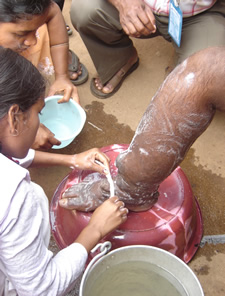
Lymphatic filariasis is one of the world’s leading causes of permanent and long-term disability. About 120 million people are affected worldwide, and 40 million people are incapacitated and disfigured by this parasitic disease that is transmitted by mosquitoes. Although transmission of this neglected tropical disease can be prevented, lymphatic filariasis is currently endemic in 81 countries and territories, and over 1.3 billion people are at risk. To address this threat, CDC has partnered with several organizations to interrupt transmission and prevent disability in those who already have the disease.
Lymphedema is a disfiguring condition that causes swelling of the limb and changes in the skin, and it is often a physically deforming consequence of lymphatic filariasis. There is no treatment available for lymphedema, but patients can improve with some basic daily management such as washing of the legs and feet to prevent infection of wounds. Lymphedema patients are more vulnerable to infections, similar to patients with advanced diabetes in their feet and legs, which can lead to life-threatening sepsis. Early treatment of bacterial and fungal infections, elevation, and exercise will also help people to manage lymphedema.
In 2008, CDC partnered with Interchurch Medical Assistance, a US-based nongovernmental organization, and provided key technical assistance in implementing large-scale lymphedema management programs.
India
An estimated 590 million of the 1.3 billion people at risk for lymphatic filariasis live in 250 districts in India and constitute about 40% of the world’s burden of this disease. Since its inception in July 2007, the Lymphedema Management Project in Orissa State has enrolled more than 5,500 patients in the program and constructed more than 5,000 sandals for patients who do not have shoes (Phase I of the project). Although wearing these sandals does not prevent lymphedema, they can prevent infections that lead to worsening lymphedema and elephantiasis of the leg.
Phase II of the project began in the summer of 2008. Three new areas of Khurda district are now part of the project, and an additional 9,000 lymphedema patients are expected to be enrolled in the program by mid-2009. Volunteers from the communities, health supervisors and personnel, patients, and family members have received both classroom and hands-on practical training in lymphedema management. To date, more than 1,200 people have been trained in 30 workshops, and 300 local volunteers have provided care to more than 5,500 lymphedema patients in the first year of the study.
Future plans include continued scale-up of the program to the entire district, enrolling close to 22,000 lymphedema patients by June 2010. This will be the largest nongovernmental organization-run lymphedema management program in India. A toolkit is being created to assist other nongovernmental organizations, in India and elsewhere, in starting their own programs.
Togo
Togo is a small, West African country of 5.5 million in which 35% of the population live in extreme poverty. With CDC’s assistance, Togo has become the first country in Africa with a national lymphedema treatment program. Health workers in more than 500 dispensaries and some 10,000 village community workers have been trained to diagnose lymphedema, discuss treatment and prevention, and provide motivation and support; about 1,000 patients with lymphedema are enrolled in the treatment program.
By using town criers, the radio, and posters, villages are building awareness of the program and encouraging villagers with lymphedema to go to dispensaries and enroll in the program. As a result, success stories abound in which patients who couldn’t walk are now walking again. Almost all patients see an improvement in their quality of life, most likely leading to the program becoming a model for lymphedema programs in other West African countries.
Increasing Vaccine Access to Children Worldwide

In low-income countries around the world, CDC has made significant contributions in introducing and administering Haemophilus influenzae type b (Hib) vaccine. The vaccine protects susceptible populations from Hib disease, one of the leading causes of severe childhood pneumonia and meningitis.
Hib disease is the estimated cause of three million cases of meningitis and severe pneumonia and is responsible for approximately 400,000 deaths worldwide per year in children five years of age and younger. Safe and effective Hib vaccines have been widely used in industrialized countries for nearly 20 years, but they have been relatively unavailable in the world’s poorest countries.
In 2000, the Global Alliance for Vaccines and Immunization (GAVI) initiated a project that provided financial support for purchasing and providing the Hib vaccine in 72 of the world’s poorest countries. From 2004–2008, the proportion of these countries using or approved to use Hib vaccine increased from 17% to 56% thanks to a focused, collaborative effort by the GAVI, the World Health Organization, and CDC. This number is projected to increase to 81% in 2009, supporting and sustaining CDC’s efforts to promote Healthy People in Every Stage of Life.
In 2004, 6.8 million children born in one of the 72 GAVI-eligible countries had access to the Hib vaccine. In 2007, 14 million of the 79 million children had vaccine access, and by the end of 2008, 43 million children are expected to have access. Several factors fostered increased interest and use of the Hib vaccine in the GAVI-eligible countries:
- Greater awareness of the amount and severity of disease caused by Hib.
- Greater encouragement by the World Health Organization that the Hib vaccine be included in routine immunization programs in all countries.
- Greater effort by GAVI to make the vaccine more affordable and accessible to the world’s most susceptible populations.
Containing Worldwide Threats

CDC has established a global network of Global Disease Detection regional centers that builds on its expertise in identifying and responding to public health threats at home. The regional centers collaborate with CDC international staff in 50 countries to detect and contain common and unique global threats that could spread to the rest of the world. In 2008, these centers discovered more than 20 new pathogens and trained 84 public health professionals to detect, diagnose, and respond to outbreaks of infectious diseases within their countries and regions. Each of the host sites have staff in three major programs: International Emerging Infections Programs, Field Epidemiology and Training Programs, and Influenza.

In 2008, CDC added the Global Disease Detection regional center in Kazakhstan to the established network of centers in Kenya, Guatemala, Egypt, Thailand, and China—achieving the goal of having a regional center in each of the six World Health Organization regions. This network unites well-established CDC resources with complementary resources from other domestic and international agencies, nongovernmental organizations, and countries.
CDC collaborated with ministries of health and other partners in 2008 to increase the number of trained epidemiologists and public health professionals throughout the world. In addition, the Global Disease Detection network expanded activities in health communication and information technology, laboratory systems and biosafety, and the relationship between animal and human illnesses. These activities help to sustain and support CDC’s Health Protection Goals of People Prepared for Emerging Health Threats and Healthy People in a Healthy World.
Notable accomplishments of CDC’s global disease detection efforts in 2008 include providing support for rapid responses to more than 250 disease outbreaks and public health events of concern:
- Avian influenza
- Respiratory diseases of unknown origin
- Poisonings
- The viral hemorrhagic fevers Ebola and Marburg
- Outbreaks of cholera in Africa
- Rift Valley fever
Pandemic Influenza Preparedness
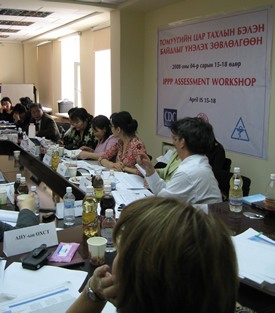
In response to infectious diseases spreading faster than any other time in history, CDC is helping countries measure their preparedness for public health threats—in particular, their ability to respond to a potential influenza pandemic. The National Inventory of Core Capabilities for Pandemic Influenza Preparedness and Response (the National Inventory) is an innovative measurement tool developed by CDC to help at-risk countries measure their ability to respond to the threat of an avian influenza pandemic.
The National Inventory has been translated into six languages and complements the World Health Organization recommendations for countries to assess their preparedness and identify immediate steps to fill gaps in public health threat preparedness.
In 2008, 42 countries assessed their ability to protect their populations using specific milestones. Those milestones included the development of a country plan, research and use of findings, communications, epidemiologic capability, laboratory capability, routine influenza surveillance, national respiratory disease surveillance and reporting, outbreak response, resources for containment, community-based interventions to prevent the spread of influenza, infection control, and health sector capacity.
Assessment Findings
- Forty-two countries have documented capabilities at a single point in time.
- Two countries have determined progress toward enhanced preparedness over time.
- Mongolia has promoted exchange of information between national and subnational levels.
- Many countries have demonstrated accountability for use of resources to donors or stakeholders.
- Many countries have reviewed logistic and operational needs and addressed deficiencies, built an inventory of country strengths, and promoted cross-border collaboration to enhance preparedness.
- Many countries have supported harmonization of national and international preparedness and response plans.
Response to Global Outbreaks in 2008
In 2008, CDC staff, with support from Global Disease Detection Regional Centers, responded to more than 90 international disease outbreaks and public health events and discovered 22 new pathogens.
CDC East turns to CDC West after Earthquake

CDC responds when disaster strikes, no matter how extreme or far away the challenge may be. However, a disaster might be so immense in scope that an unprecedented response is required.
That certainly was the case when a massive earthquake devastated Sichuan province on May 12, 2008. Public health facilities in Sichuan province were demolished by the earthquake. China CDC (named after CDC) had little or no capacity to assess the region’s health needs or monitor for potential disease outbreaks.
Responding to this urgent need, CDC experts worked with the CDC Foundation, private technology companies, and counterparts at China CDC to rapidly establish an emergency public health response system using state-of-the-art mobile technology. Because the use of mobile technology for surveillance is still an emerging tool in public health, neither CDC nor China CDC had an adequate number of handheld devices.
With coordination by the CDC Foundation, Hewlett Packard donated 500 HP Ipaq Travel Companions with Global Positioning System (GPS) technology to China CDC. Microsoft also donated handheld mobile devices directly to China CDC. USGlobalSat, Inc., a subsidiary of GPS manufacturer GlobalSat Technology of Taiwan, provided wireless Bluetooth GPS receivers to ensure that the devices donated by Microsoft had the GPS capabilities required by emergency response teams.
In early June 2008, a CDC team flew to Beijing to provide hands-on technical advice and training to China CDC on the use of the Field Adapted Survey Toolkit (FAST) exchange software and mobile technology. Disaster response forms from the CDC were translated into Chinese and incorporated into the FAST application. China CDC staff were trained on the basics of data collection and how to install and operate both the system and the equipment.
The relief assistance CDC provided during the earthquake relief effort is a model for public-private partnerships and showcases how international technical assistance can be accomplished through the practice of global health diplomacy. With the donated equipment and the new system that CDC helped design, China CDC is now able to quickly collect public health data in areas where communications capacity has been destroyed and send it to China CDC headquarters for analysis.
As efforts in China have shifted from emergency response to recovery, the health and well-being of an estimated five million displaced persons provides additional opportunities for CDC and China CDC to learn new lessons as they collaborate to rebuild the public health infrastructure in Sichuan province.
“Amazing” HIV Support Group
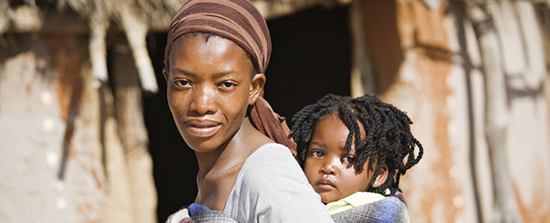
Lucy Auma was filled with dread when she learned that she was HIV positive. Not only would her infection cut her life short, but it would likely be passed on to her unborn child. As news about her diagnosis spread through her Kenyan village, she became an outcast, with no one to share her fears with.
One day, as she waited for a checkup at a CDC-funded clinical research center in the New Nyanza Province, she overheard several women openly discussing their experiences with stigma and discrimination. She was so moved by what she heard that she joined in the discussion. Hungry for each others’ support, the women soon formed the “Amazing Support Group.” Twice a month, they assemble at the clinical research center to talk about their problems, listen to health talks, and receive counseling from other people who have been through similar experiences.
“We share so much, and we have become like sisters,” says Lucy. “It is good to know that it’s not only me who is suffering.”
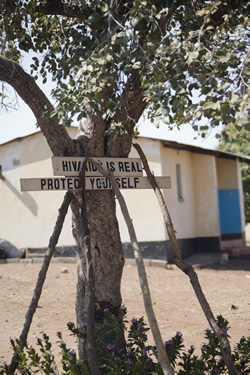
Lucy’s good fortune didn’t end there. She and other women in her group were part of the Kisumu Breastfeeding Study that started in 2003. The study investigated the effectiveness of giving antiretroviral drugs to women during pregnancy and during the first months of breastfeeding to reduce HIV infection in infants. The study was carried out by CDC, the Kenya Ministry of Health, and the Kenya Medical Research Institute.
In 2008, analysis of the breastfeeding study showed remarkable results: treating HIV-infected mothers with antiretroviral drugs from 34 weeks of pregnancy to six months after delivery reduced mother-to-child transmission to only 6% after one year. The historical transmission rate in women not treated with antiretroviral drugs has been 30%–40%.
Now, four years later, Lucy is the proud mother of a healthy boy who is HIV negative. To date, more than 400 women have benefited from the “Amazing Support Group.” “We called ourselves amazing,” Lucy says, “because it is amazing that a HIV-positive mother can give birth to a HIV-negative child.”
Work Continues in Kenya Despite Post-election Violence

More than 1,000 people were killed and another 300,000 displaced as a result of violent protests when members of rival political parties contested the Kenyan presidential election in December 2007. During the two months following the protests, CDC offices in Nairobi and Kisumu, including clinics in the Kiberia settlement and rural Kenya, were closed periodically because of concerns for staff safety. The public health work being done at CDC Kenya and its partner institution, the Kenya Medical Research Institute (KEMRI), continued throughout this chaotic period. As others fled the region, many KEMRI/CDC staff reported to work at the Lwak Mission Hospital and the Tabitha clinic in Kiberia to provide critical care and treatment.
Initially, the KEMRI/CDC staff focused on maintaining hospital operations while many colleagues returned to their home districts to vote. The remaining team cared for the regular flow of people sick with malaria, pneumonia, HIV—in addition to the surge of patients injured during the post-election violence. The KEMRI/CDC clinical team and community workers also continued to visit households in the surveillance areas to collect health status data.
The KEMRI/CDC staff had strong local support from the community who staged mock demonstrations to keep troublemakers away so that the hospital could remain open. “It’s true we were frightened,” said Mary Agola, a nurse. “But we felt a responsibility to our work as well as to the people who were affected by the violence. Other hospitals had closed and people were coming long distances for help.” Staff replacements began arriving the week of January 7th, but KEMRI/CDC staff continued working until January 20th to be sure that people who needed care received it. As a result, the Lwak Hospital never closed its doors.
The KEMRI/CDC collaboration joined Red Cross International and other partners in Nyanza Province to provide medical care. The Kisumu Field Station in rural Kenya held a blood drive and collected 32 pints of blood for use in community hospitals. Through temporary medical camps they provided drugs, medical care, psychosocial support and nutrition support, voluntary counseling, testing for HIV, food, and legal support. Likewise, in Nairobi, KEMRI and CDC medical officers, clinical officers, and nurses provided primary health care in camps for displaced persons. On February 2nd, more than 1,000 people attended one such camp. KEMRI/CDC staff distributed malaria treatment and bed nets and several staff attended “alternatives to violence” workshops to discuss ways to bring peace to their own lives and their communities.
CDC Lab in Kenya Achieves International Accreditation
After a thorough review by the World Health Organization, CDC-Kenya’s HIV research laboratory became the first medical research laboratory in Kenya and the first international CDC laboratory to achieve international accreditation. By adopting quality management and implementation systems, the HIV research laboratory received accreditation from the South Africa National Accreditation System in March 2008.
Only labs that can demonstrate competence, capability, and strict international standards earn the coveted status. The lab was the first in Kenya and East Africa to perform early infant HIV-1 diagnosis by DNA polymerase chain reaction (PCR), a molecular biology technique that can be used to diagnose HIV-1 early in infants so they can access treatment soon after they are born. Standard HIV tests, which screen for HIV antibodies, cannot reliably identify children as being HIV-infected until after 18 months of age due to the presence of maternal antibodies.
The laboratory staff trained and helped establish these types of laboratories in other parts of Kenya and in Tanzania, Cameroon, and Nigeria. With this capability, Kenya is working to achieve 100% testing coverage.
Staying Healthy at the Olympics
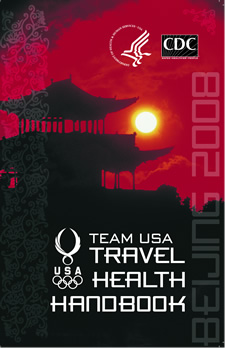
No one will soon forget the record-breaking performances and inspiring stories from the 2008 Beijing Olympic and Paralympic Games. For CDC, the games presented a golden opportunity to educate US athletes on avoiding travel-related illnesses, while also developing a lasting partnership with the United States Olympic Committee (USOC).
Travel health experts used research published by CDC before the Olympics to learn the most commonly reported health issues in travelers to China: respiratory infections, skin problems, diarrhea, and injuries (including dog bites). Armed with these data and a growing relationship with the USOC, CDC began to develop creative strategies for educating Beijing-bound travelers on staying healthy.
A team of health communicators developed health education materials with input from USOC contacts for US athletes, coaches, and Olympic team staff, reinforcing CDC’s work to protect and promote Healthy People in a Healthy World. In addition, the team created materials for the general public and health care providers:
- The Team USA Travel Health Handbook was created and distributed to 1,400 members of the US delegation, and it provided information tailored to the specific needs and concerns of athletes, such as medications and doping regulations.
- Posters were placed in housing and recreation areas in Beijing to remind US athletes how to avoid foodborne illnesses, insect bites, sunburn, and heat-related illnesses.
- A Web page was housed on the CDC Travelers’ Health Web site called Gold Medal Travel Health Tips for the 2008 Olympic Games. This site linked to health information for the general public, children, health care providers, and participating Olympic and Paralympic athletes.
- Three electronic greeting cards were created that focused on travel health, and one was created especially for athletes to send to each other.
- A podcast was created that used special characters to educate children on how to stay healthy while at the Olympics.
CDC and the USOC continue their partnership in evaluating communication efforts and conducting focus groups with US delegation members. In addition, CDC’s Travelers’ Health Communication and Education Team will create additional travel health posters to be placed permanently at the USOC training headquarters in Colorado Springs, Colorado. Our CDC team will continue to work towards keeping US athletes and spectators healthy as they travel to “bring home the gold!”
2007
Hunting Down the Source of the Deadly Marburg Virus

In In the summer of 2007, a team of CDC researchers entered a dark, hot mine in western Uganda, searching for something more valuable than precious metal. Forty years had passed since the first reported outbreak of the deadly Marburg virus in a German laboratory. Now, a world away, they were tracking down the source of one of the most deadly pathogens known to man.
When two miners fell ill at the Kitaka mine in Uganda from Marburg hemorrhagic fever in early August 2007, CDC staff quickly contained the outbreak and acted on a rare opportunity to trace the outbreak to its source.
“The public health response is first and foremost,” says Jonathan Towner, PhD, a microbiologist with CDC. “But because the outbreak was limited, it allowed us to very quickly mount an ecological study where we could look for the Marburg virus reservoir.”
By choosing to limit the focus of the investigation to the mine, the pool of potential natural hosts was narrowed to the bat species inhabiting the mine, two of which were already familiar to the CDC team: a small, insectivorous bat, and a larger fruit bat.
Earlier that year, the CDC team, with scientists from Gabon, had conducted an ecological investigation that showed evidence of Marburg virus infection in the fruit bat. This was the first study to definitively document evidence of the virus in wild nonprimates. It was also the first study to document evidence of Marburg virus in the Central African country of Gabon. The Ugandan mine provided a timely opportunity to continue the research efforts.
Wearing full safety gear—masks, gloves, boots and gowns—the research team and collaborating South African scientists entered the Kitaka mine hoping to build upon the results from Gabon. At the mouth of the cave, the team set up nets that trapped the bats as they left the cave at night to forage for food. Thus began a nightly ritual that lasted for nearly three weeks. The bats caught in the traps were taken back to a lab for analysis.
By the time the CDC team left in early September, they had collected more than 1,000 bats and assisted the Ugandan Ministry of Health in tracing every known contact of the infected miners through the 21-day incubation period to ensure that the outbreak had been contained.
“The discovery of Marburg virus infection in fruit bats in Gabon helped guide our investigation in Uganda,” said Towner. “We are still in the process of testing all of the bats that were trapped at the Ugandan mine. If infected bats are found in this collection, we could be a little closer to learning how the bats might have transmitted the Marburg virus to the miners.” Discovering the mode of transmission could assist with implementing risk reduction measures and aid CDC’s goal to protect Americans at home and abroad from health threats through a transnational prevention, detection and response network.
Marburg virus is a member of the same family of viruses as Ebola, i.e., Filoviridae. It was first recognized in 1967, after outbreaks of hemorrhagic fever occurred in laboratories in Marburg (hence the name) and Frankfurt, Germany, and in Belgrade, Yugoslavia (now Serbia). Marburg causes a severe and often fatal illness in humans and nonhuman primates. There is no vaccine to prevent the disease and no specific treatment. Humans become infected with Marburg virus by direct contact with blood or body fluids or with objects contaminated with body fluids from an infected animal or human. Reports of this disease are rare, but there have been recent occurrences in countries in sub-Saharan Africa.
Basic Care Package Curbs Three Diseases
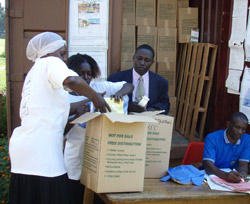
Sometimes, the simple things in health prevention are surprisingly effective. That certainly is true of an innovative intervention that is saving lives across Africa, one that contributes to CDC’s goal to promote health around the globe by sharing knowledge and tools to protect health.
The Basic Care Package is being distributed in Uganda and other African countries through a collaborative effort among CDC, the Uganda Ministry of Health, the AIDS Support Organization, and other partners, and through support from the President’s Emergency Plan for AIDS Relief (PEPFAR). Research conducted in rural Uganda and elsewhere in Africa demonstrated that the Basic Care Package is a low-cost, evidence-based way to reduce deaths, hospital visits, and illnesses, including malaria and diarrhea, among HIV-positive persons and their families.
The package includes two insecticide-treated mosquito nets; a water vessel, filter cloth, and bleach solution to disinfect water; information on HIV prevention and care (including cotrimoxazole, an antibiotic used to reduce opportunistic infections in persons who are positive for HIV); information on how to use the package components; and condoms when requested. Studies conducted by CDC and its partners show that the daily use of cotrimoxazole has reduced mortality by 46%; bed nets have reduced malaria incidence by 50%; and the simple home based safe water system has reduced diarrheal disease by 25%. In the last two and a half years, 120,000 Basic Care Packages have been distributed to HIV-positive families in Uganda alone.
Safe Water System to Save 500 Children per Day
“Unsafe water is a key health risk.” That simple statement drives a health intervention that is making a difference in the lives of people across the globe and is now receiving national recognition.
Through implementation of its Safe Water System Initiative, CDC is delivering a simple solution to some of the world’s most complex health problems. Over 1.1 billion people worldwide do not have access to safe drinking water. As a result, diarrhea and other preventable waterborne diseases claim the lives of an estimated 2 million children each year.
The initiative helps people store their water safely and treat it with a chlorine solution before use. It is economically self-sustaining through local entrepreneurship; and each year the initiative shows increased progress and promise. The system has been proven to reduce diarrheal disease in users by 22%–84%. Additionally, the chlorine treatment costs 25 cents for a 4-to-6 week supply, making it an affordable option in some of the world’s poorest communities.
In collaboration with CDC’s Partner, Population Services International (PSI), approximately 12 million bottles of chlorine solution were sold in 19 countries between 2006 and 2007. This amount is sufficient to treat more than 12 billion liters of water—enough drinking water for 16.5 million people in FY2007.
Point-of-use water treatment is relatively new to the scene but is gaining recognition as indicated by the recent creation of the International Network for the Promotion of Household Water Treatment and Safe Storage. This network includes dozens of organizations and a secretariat based at the World Health Organization.
Clean drinking water is especially critical for HIV-infected persons, whose weakened immune systems make them vulnerable to opportunistic infection, some of which are spread through unclean water. In western Kenya, nearly one in five adults is infected with HIV and nearly 20% of children are orphaned. A “Basic Care Package” developed by CDC includes the Safe Water System (water vessel, filter cloth, and bleach solution) as well as instructions for household water treatment methods.
The Safe Water System alone has been documented to reduce diarrhea among HIV-infected persons by 25%–35%, at a cost of only $10 per family per year. When combined with the powerful antibiotic cotrimoxazole (Bactrim), the system has reduced diarrhea episodes by 77%.
This low-cost and effective intervention is being scaled up under the President’s Emergency Plan for AIDS Relief, and supports CDC’s goal to promote health around the globe by sharing knowledge and tools to protect health. Over the past year, the Safe Water System Initiative has grown to a total of 19 countries, and new programs were launched in Ethiopia, Burundi, Guinea, and Cameroon, with Haiti and Angola not long behind. CDC estimates that expansion of the program could save the lives of up to 500 children every day.
CDC Scientists Contain Ebola Outbreaks in Congo and Uganda
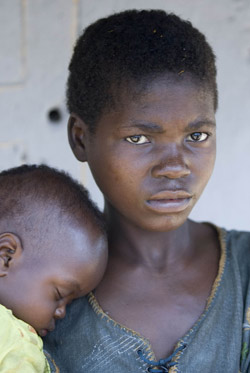
When reports of unexplained deaths trickled in from a remote section of the Democratic Republic of Congo in August 2007, CDC scientists knew what they might be up against. Twelve years earlier but only 185 miles away from the location of the current report, a group of CDC scientists had battled an outbreak of Ebola hemorrhagic fever.
Reports from the region included descriptions of varied symptoms, making accurate clinical diagnosis impossible. Still, CDC scientists wondered whether the highly fatal, highly contagious Ebola virus might have struck again, this time in the murky context of other endemic diseases.
After receiving samples from the affected area, CDC scientists were able to diagnose Ebola virus infection in some patients. Evidence of Shigella dysenteriae and Salmonella typhi infection was also observed. The scientists alerted the World Health Organization and a CDC physician was deployed to assess the situation as part of CDC’s Global Diplomacy goal to be a trusted and effective resource for health development and health protection around the globe. On September 10, CDC’s Special Pathogens laboratory and a lab in Gabon confirmed the outbreak as Ebola. CDC and its partners were able to contain the outbreak in a few weeks through intensive contact tracing, patient management and laboratory testing of samples on site. CDC lab staff also trained Congolese scientists at the National laboratory in Kinshasa in diagnostic methods for Ebola hemorrhagic fever.
A short eight weeks later, in neighboring Uganda, Ebola struck again in the western district of Bundibugyo. This time, however, the virus was different. CDC scientists noticed that the virus was not behaving as would have been expected of some of the known Ebola strains. They realized that this was probably a novel or new strain of Ebola.
Further analysis confirmed suspicions – a novel fifth strain of Ebola virus was causing the outbreak. The team worked quickly to develop and deploy a laboratory assay for the new strain. CDC assembled two field teams to help contain the Ugandan outbreak. Recent upgrades to the laboratory in Entebbe allowed for same-day testing and reporting of results, accelerating efforts to bring the outbreak to an end.
Ebola hemorrhagic fever is caused by a virus from the same family as the one that causes Marburg hemorrhagic fever. Both diseases are rare, but can cause dramatic outbreaks with human-to-human transmission and 50%-90% fatality rates. It is transmitted by contact with the blood, secretions, organs or other bodily fluids of infected persons. There is currently no specific treatment or vaccine.
To learn more about Ebola virus please visit: http://www.cdc.gov/ebola
A Health Mystery in Panama
In October 2006, after dozens of Panamanians suddenly fell ill from unexplained renal failure, the country’s minister of health turned to CDC. Twelve of 21 patients had already died when a team of CDC epidemiologists, medical toxicologists, and infectious diseases specialists landed in Panama. They quickly distributed supplies and equipment to gather medical data and diagnostic samples from patients—and sent them back using CDC’s leased airplane.With assistance from the FDA and international partners, the CDC team identified the source of the mysterious illness in just nine days—cough syrup contaminated by diethylene glycol, which is commonly found in brake fluid and antifreeze. This rapid response allowed Panamanian health authorities to quickly withdraw the contaminated medications from clinics, and begin a national public health prevention and risk communication program. Although more than a hundred people were sickened by the poison, the rapid response saved many lives.
Contact Us:
- Centers for Disease Control and Prevention
1600 Clifton Rd
Atlanta, GA 30333 - 800-CDC-INFO
(800-232-4636)
TTY: (888) 232-6348 - cdcinfo@cdc.gov


